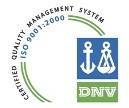First Two Stroke Gas Engines for LNG Carriers

Teekay LNG Partners has ordered two 173,400m3 LNG carriers from Daewoo Shipbuilding & Marine Engineering in Korea. The vessels will each have two MAN Diesel & Turbo ME-GI dual-fuel, ultra long two-stroke gas injection engines. These engines received DNV type approval in 2010 and their use as part of an innovative propulsion package is claimed to give significant fuel savings when compared to propulsion commonly used for LNG carriers today. DNV experience from risk assessments of LNG-fuelled ships shows that a gas-fuelled main engine has the same risk level as a diesel-fuelled main engine.
LR Wins Landmark LNG Deal
Lloyd’s Register has won the classification contract for four 155,000 cu-m Technigaz Mk III membrane-type LNG carriers, ordered by BP Shipping at Hyundai Heavy Industries (HHI) with a further four options. These ships are the largest LNG carriers ordered to date. The ships are also noteworthy in that they will have dual fuel diesel electric propulsion and will be the first LNG ships with this type of propulsion to be built in Korea. Only a handful of LNG carriers in the world feature this form of propulsion, with most owners and operators opting for steam turbines. The last of the first four ships will be built at Hyundai’s Samho yard, representing this particular yard’s first LNG carrier.
LR Guidance on Partial Filling of LNG Tanks
Lloyd’s Register has published a set of comprehensive guidelines to help owners, operators and builders of membrane-type LNG tankers to assess the ability of a containment system to withstand sloshing loads. The guidelines are entitled Comparative sloshing analysis of LNG ship containment systems and provide a means of fulfilling the requirement to take sloshing into account during containment system design in Lloyd’s Register’s Rules and Regulations for the Construction and Classification of Ships for the Carriage of Liquefied Gases in Bulk. In addition, owners and operators now have a robust method for examining site-specific and voyage-specific partial filling of membrane cargo tanks in both ships and offshore floating structures.





